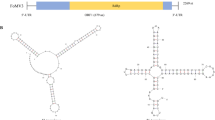Abstract
In this work, we describe the complete sequence and genome organization of a novel tobamovirus detected in a prickly pear plant (Opuntia sp.) by high-throughput sequencing, tentatively named “opuntia virus 2”. The full genome of opuntia virus 2 is 6,453 nucleotides in length and contains four open reading frames (ORFs) coding for the two subunits of the RNA polymerase, the movement protein, and the coat protein, respectively. Phylogenetic analysis using the complete nucleotide sequence revealed that the virus belongs to the genus Tobamovirus (family Virgaviridae), showing the highest nucleotide sequence identity (49.8%) with cactus mild mottle virus (CMMoV), being indicating that it belongs in the Cactaceae subgroup of tobamoviruses.


Similar content being viewed by others
References
Sánchez LDL, López GC, Ávalos HI (2013) Nomenclatura vernácula, uso y manejo de Opuntia spp. en Santiago Bayacora, Durango, México. Revista Chapingo Serie Horticultura 19:367–380
Alonso BB, Mora AG, Valdovinos PG, Ochoa MDL, Rodríguez LE, De La Torre AR (2015) Asociación de un Potexvirus como agente causal de manchas cloróticas en Opuntia ficus-indica. Rev Mex Fitopatol 33:75–86
De La Torre AR, Salgado OH, Salazar SM, Pallás V, Sánchez NJA, Valverde RA (2016) First report of Schlumbergera virus X in prickly pear (Opuntia ficus-indica) in Mexico. Plant Dis 100(8):1799
De La Torre AR, Salgado OH, Salazar SM, Pallás V, Sánchez NJA, Valverde RA (2016) First report of Rattail cactus necrosis-associated virus in prickly pear fruit (Opuntia albicarpa Scheinvar) in Mexico. Plant Dis 100(11):2339
Min BE, Chung BN, Kim MJ, Ha JH, Lee BY, Ryu KH (2006) Cactus mild mottle virus is a new cactus-infecting tobamovirus. Arch Virol 151(1):13–21
Kim NR, Hong JS, Song YS, Chung BN, Park JW, Ryu KH (2012) The complete genome sequence of a member of a new species of tobamovirus (rattail cactus necrosis-associated virus) isolated from Aporocactus flagelliformis. Arch Virol 157(1):185–187
Adams MJ, Antoniw JF, Kreuze J (2009) Virgaviridae: a new family of rod-shaped plant viruses. Arch Virol 154(12):1967–1972. https://doi.org/10.1007/s00705-009-0506-6
Lecoq H, Desbiez C (2012) Viruses of cucurbit crops in the Mediterranean region: an ever-changing picture. Adv Virus Res 84:67–126
Haas BJ, Papanicolaou A, Yassour M, Grabherr M, Blood PD, Bowden J, Regev A (2013) De novo transcript sequence reconstruction from RNA-Seq: reference generation and analysis with Trinity. Nat Protoc 8(8):1–43
Altschul SF, Madden TL, Schäffer AA, Zhang J, Zhang Z, Miller W, Lipman DJ (1997) Gapped BLAST and PSI-BLAST: a new generation of protein database search programs. Nucleic Acids Res 25:3389–3402
Kumar S, Stecher G, Tamura K (2016) MEGA7: molecular evolutionary genetics analysis version 7.0 for bigger datasets. Mol Biol Evol 33(7):1870–1874
Song YS, Min BE, Hong JS, Rhie MJ, Kim MJ, Ryu KH (2006) Molecular evidence supporting the confirmation of Maracuja mosaic virus as a species of the genus Tobamovirus and production of an infectious cDNA transcript. Arch Virol 151:2337–2348
Gibbs AJ, Wood J, Garcia-Arenal F, Ohshima K, Armstrong JS (2015) Tobamoviruses have probably co-diverged with their eudicotyledonous hosts for at least 110 million years. Virus Evol 1(1):vev019
Adams MJ, Adkins S, Blagard C et al (2018) International Committee on Taxonomy of Viruses (ICTV) Report on the taxonomy of the Virgaviridae. http://www.ictv.global/report/virgaviridae. Accessed 19 Oct 2018
Acknowledgements
The first author would like to thank Consejo Nacional de Ciencia y Tecnología for the Grant (number 446131) that supported his Doctoral scholarship, and Posgrado de Ciencias Biológicas of Universidad Nacional Autónoma de México (UNAM). We thank the Instituto de Biotecnologia-UNAM for giving us access to their computer cluster.
Funding
This study was funded by project no. IN216317 of UNAM-Programa de Apoyo a Proyectos de Investigación e Innovación Tecnológica (PAPIIT) and by Grant BIO2017-88321-R from the Spanish Agencia Estatal de Investigación (AEI) and Fondo Europeo de Desarrollo Regional (FEDER).
Author information
Authors and Affiliations
Corresponding author
Ethics declarations
Conflict of interest
The authors declare that they have no conflict of interest.
Ethical approval
This article does not contain any studies performed on human participants or animals by any of the authors.
Additional information
Handling Editor: Ralf Georg Dietzgen.
Publisher's Note
Springer Nature remains neutral with regard to jurisdictional claims in published maps and institutional affiliations.
Electronic supplementary material
Below is the link to the electronic supplementary material.
Rights and permissions
About this article
Cite this article
Salgado-Ortíz, H., De La Torre-Almaraz, R., Sánchez-Navarro, J.Á. et al. Identification and genomic characterization of a novel tobamovirus from prickly pear cactus. Arch Virol 165, 781–784 (2020). https://doi.org/10.1007/s00705-020-04528-3
Received:
Accepted:
Published:
Issue Date:
DOI: https://doi.org/10.1007/s00705-020-04528-3




